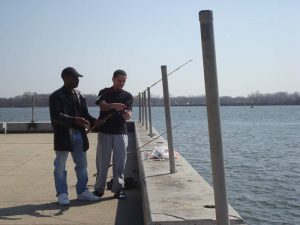
On an unseasonably warm March afternoon, a group of four fishermen lines the pier at Pulaski Park. They bait their hooks with shrimp and cast their lines into the Delaware River. Some days they catch catfish. Other days they don’t. But they visit the park frequently, especially in the warmer months, to fish and to relax. “I’ve seen more than 50 people here at once during the summertime,” says Victor Delgado, a Port Richmond resident in his mid-twenties. “People come here to have picnics and have a good time. They fish, eat, throw their trash out and we all go home,” he describes, motioning toward a large burn barrel on the pier. “It’s a great place—Pulaski Park. I’ve been coming here for six years.”


Named after a Polish military commander and Revolutionary war hero, this half-acre sliver of greenery along the Delaware is squeezed between two industrial sites and is located just off the bustling intersection of Richmond Street and Allegheny Avenue in Port Richmond. Tractor trailers plug along Allegheny Avenue before stopping to unload in the massive parking lot to the left of Pulaski Park on their way to the towering I-95 overpass, which obstructs views of the park and the waterfront. “This impoundment lot could be anywhere. It does not need to take up a prime spot along the river,” explains Regina Gorzkowska, president and founder of Pro Arte Associates, a non-profit conservation group geared toward revitalizing the park in conjunction with other civic organizations, including the Friends of Pulaski Park, the Pennsylvania Horticultural Society and the Polish Business Association. “I-95 is blocking the view—that’s why the park was forgotten,” Gorzkowska adds. “We want to sink this section of the highway so there is a direct view of the park at all times.”
Regina Gorzkowska talks about her involvement with the revitalization of Pulaski Park, sitting beside a watercolor of the park done by Stanley Mitchell.
Regina’s wishes to sink the highway, swallow the parking lots and revitalize Pulaski Park and the whole of the Port Richmond waterfront are not far-fetched. One of only two green spaces along the central Delaware riverfront, Pulaski Park’s revitalization would serve as a building block for the implementation of a broader, civic vision for the riverfront, a vision being led by Dr. Harris Steinberg, executive director of PennPraxis, the clinical arm of the School of Design at the University of Pennsylvania.





I lived in Port Richmond all my life. The park was a cool place to hang when the fire department was stationed there. Now it is a disgusting mess as are parts of Port Richmond and I am embarrassed to call Port Richmond my home. I see new homes and revitalization happening in depressed areas but since Port Richmond is not plagued with such problems we are pushed to the side. If nutter does not take of Port Richmond it will more than likely turn into a drug infested, unsafe neighborhood. Pulaski Pier is already an eyesore and hangout for degenerates. I feel bad for the good people who still live here and visit this place.